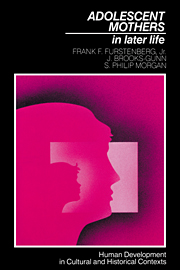Book contents
- Frontmatter
- Contents
- List of tables and figures
- Preface
- 1 Reassessing adolescent parenthood
- 2 Experience in adulthood
- 3 Pathways to success in adulthood
- 4 The children's experience
- 5 The intersecting life courses of adolescent mothers and their children
- 6 The life course of adolescent mothers: implications for public policy
- Appendixes
- A Life-history calendar
- B Reliability
- C Analysis of sample attrition for bias
- D Description of data sets used for comparison of socioeconomic variables with Baltimore data set in Table 2.2
- E Methods and procedures used in Chapter 3
- F Description and details of multivariate analysis reported in Chapter 4 and 5
- G Procedure for computing summary statistics in Chapter 6
- Bibliography
- Index
C - Analysis of sample attrition for bias
Published online by Cambridge University Press: 04 August 2010
- Frontmatter
- Contents
- List of tables and figures
- Preface
- 1 Reassessing adolescent parenthood
- 2 Experience in adulthood
- 3 Pathways to success in adulthood
- 4 The children's experience
- 5 The intersecting life courses of adolescent mothers and their children
- 6 The life course of adolescent mothers: implications for public policy
- Appendixes
- A Life-history calendar
- B Reliability
- C Analysis of sample attrition for bias
- D Description of data sets used for comparison of socioeconomic variables with Baltimore data set in Table 2.2
- E Methods and procedures used in Chapter 3
- F Description and details of multivariate analysis reported in Chapter 4 and 5
- G Procedure for computing summary statistics in Chapter 6
- Bibliography
- Index
Summary
Several procedures were used to examine possible biases due to sample attrition. First, ten key indicators of the young mothers' status at the beginning of the study were inspected: (1) age, (2) race, (3) length of residence in Baltimore, (4) frequency of church attendance, (5) school performance, (6) the marital status of her parents, (7) her mother's education, (8) whether her mother was a teenage parent, (9) whether she was on welfare before she became pregnant, and (10) whether she participated in the comprehensive health program at Sinai Hospital. Four of these variables were unrelated to attrition in the bivariate tables and were dropped from the subsequent analysis – mother's education, the marital status of the parents, whether the adolescent mother had been on welfare as a child, and whether she had participated in the Sinai comprehensive care program.
The remaining six variables were examined in a logistic regression analysis to determine the predictive value of each of the variables controlling for all others. A separate multiple-classification analysis explored potential interactions among the separate predictors of attrition. The multivariate procedures considerably reduced the number of determinants. The most powerful predictor by far was residential stability. Adolescents who had lived in Baltimore for less than 4 years at the beginning of the study were a third less likely to participate in the 17-year follow-up. Presumably, these women were more likely to move elsewhere and therefore harder to trace.
- Type
- Chapter
- Information
- Adolescent Mothers in Later Life , pp. 161 - 162Publisher: Cambridge University PressPrint publication year: 1987



